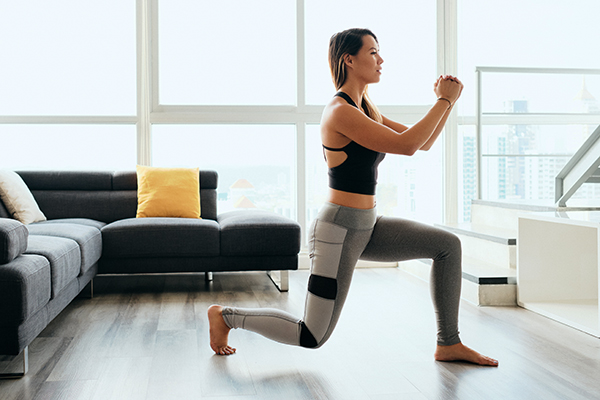Do you want to know more about strength training for beginners? Scroll down for key facts and tips for getting started from this article by Paige Smith.

Strength training is one of the best types of exercises out there. Not only is it a great way to build muscle, burn fat, and improve your muscular endurance, it’s also easy to do at home with minimal equipment.
The best part? Strength training is a good workout for everyone, regardless of age, gender, or fitness level.
Curious to know more about strength training for beginners? We’ve got you covered.
Keep reading for key facts and tips for getting started.
What Is Strength Training?
“Strength training is a form of exercise that utilizes resistance to build muscular strength and endurance,” says Cody Braun, CPT.
Many people associate strength training with weights, but it can take a lot of different forms.
For example, bodyweight exercises like push-ups and squats qualify as strength training.
Strength training is any exercise that “challenges your muscles to improve their strength and ability,” says K. Aleisha Fetters, CSCS and author of “Give Yourself More.”
What Are the Benefits of Strength Training?
Strength training has countless benefits, including increased mobility, greater strength, and improved function in your everyday life.
Training your muscles can help you take on daily tasks with more confidence and less strain.
Think: “Moving furniture by yourself, reaching for something above the dryer, or lifting your luggage into an overhead bin,” says Fetters.
Strength training also helps you stay healthy as you age.
“Your muscular tissue declines with age, which means your muscular ability is dropping unless you’re actively training it,” Fetters says.
Regular strength training is a good way to maintain and build muscle tissue. Plus, it may increase your metabolic rate over time, helping you burn calories easier.
Another benefit is that as you build muscle, you also increase your body’s capacity to push itself harder in workouts, Fetters says.
As a result, you may be able to exercise longer, up your intensity, and burn even more fat.
How Often Should I Strength Train?
How often you do strength training depends on your fitness level, goals, and schedule.
Before you map out a plan, be realistic about your time constraints.
“How many days are you actually going to work out per week? How much can you commit as a bare minimum?” Fetters says.
In general, strength training three days a week for 30 to 60 minutes each time is a good place to start as a beginner.
This schedule also works well if you’re trying to lose weight; just make sure you do a mix of aerobic workouts (a.k.a., steady-state cardio) and strength training.
“The cardio will help you burn calories and recover from strength training, and strength training will help ensure that whatever weight you lose comes from fat and not muscle,” Fetters explains.
On the other hand, if your goal is to build muscle mass, “You should aim to hit each muscle group at least three times a week to create enough volume to induce hypertrophy,” Braun says.
Depending on your weekly exercise routine, that might involve doing three total-body workouts where you target every muscle group, or doing a “split routine where you alternate between upper and lower body days,” he adds.
Whatever your schedule, it’s important to give yourself enough time between strength workouts to rest the muscle groups you activated.
And remember: it’s OK to introduce strength training slowly.
“If you go from nothing to three days a week for an hour each time, you might feel wrecked and hurt yourself,” says Fetters. “Start where you are, and keep increasing as you feel comfortable.”
Looking for a strength-training program to help you get started? Check out Sure Thing with Megan Davies.
Her 8-week program is a science-based approach to fitness called “type training.”
Megan alternates weekly between endurance and power-based strength training plus cardio conditioning to target both slow-twitch and fast-twitch muscle fibers.

How Many Reps and Sets Should I Do?
As a beginner, Braun recommends starting with six to 12 reps per set at a moderate to heavy weight, and aiming for two to three sets per exercise.
If you’re not sure how much weight to pick up, start with a low weight and try a few reps, Fetters says.
“You’re more likely to get injured picking up a weight that’s too heavy. Plus, mentally, it can feel demoralizing to start with a heavy weight, and it’s important to have a feeling of competence to motivate you to keep going,” she says.
As you go, pay attention to how the load feels.
The goal is to challenge your muscles to the point of fatigue, Fetters says, but not failure.
“As you finish your last set, you want to feel like you have about two more quality reps left in the tank before your form collapses,” she says.
Keep in mind that strength training isn’t about speed. Resetting between your reps and resting between sets is crucial to maintaining good form, says Fetters.
“If you’re working in that eight to 12 rep range,” she says, “a good general rule is to give yourself 30 to 90 seconds of rest between each set, and 90 seconds between exercises.
Strength Training for Beginners: 3 Tips to Get Started
Make the most of your workouts with these three tips.
1. Focus on Form
Whether you’re using dumbbells or doing bodyweight exercises, proper form is critical.
“If your form starts to break down,” Fetters says, “you won’t get as much out of the exercise and you’ll simultaneously increase your risk of getting injured.”
How do you know if your form is correct?
Watch a certified trainer (either online or in person) perform the movement and explain their posture, then check yourself in a mirror.
Braun also recommends using lighter weights or doing bodyweight exercises until you’re comfortable with the movements of each exercise.
If you’re using the correct technique, you should “feel a burn in the belly of your muscles that builds with each rep,” Fetters says. “But if you feel a sudden, sharp pain or something near a joint, that’s a cue to stop, reset your form, and try again.”
2. Adjust Your Expectations
The key to a successful beginner’s strength training workout is to manage your expectations.
“With anything fitness-related, people always expect results much faster than they occur,” Fetters says.
But building muscle takes time.
“You have to be consistent and patient and know that even though you can’t see results in the mirror, they are occurring,” she adds.
3. Prioritize Recovery
Recovery is just as critical to your muscle development as strength training itself.
Make sure you take rest days and recovery days.
For active recovery activities, she recommends going for a walk, cycling at low intensities, or stretching.
Using a foam roller throughout the week can also help.
“Foam rolling increases blood flow to the sore muscles,” Braun says, “which can speed up the recovery process.”

Strength Training Program for Beginners
Your body’s basic movement patterns include a squat, lunge, hinge, push, pull, and carry.
“If you do all those in a workout, you’ll be relatively balanced, hitting all your major muscle groups and functions,” Fetters says.
The foundational exercises below are perfect for a beginner strength-training routine for weight loss or increased muscle mass.
1. Squat
Squats hit almost every muscle in your lower body, including your glutes, quads, hamstrings, adductors, and calves.
To do a squat:
- Stand with your feet shoulder-width apart, toes facing straight ahead.
- Keep your back flat (not rounded) and push your hips back as you bend your knees. Lower your body until your thighs are parallel to the floor. “Sit” into the exercise, pushing your butt back like you’re sitting down on a chair.
- Don’t bend over at the waist; keep your back flat and chest up throughout the movement.
- Pause, then push up to the starting position and repeat.
2. Lunge
Lunges work your glutes, quads, and hamstrings, and they also help with balance.
To do a forward lunge:
- Stand with your feet hip-width apart.
- Step forward with your right leg. Make sure your heel hits the ground first.
- Lower yourself down until your right thigh is parallel with the ground and your left knee is bent 90 degrees.
- Press off your right heel back to standing position, then repeat.
3. Deadlift (hinge)
Deadlifts are great for challenging your hamstrings and glutes. If you use weights, you’re also working your core and back muscles.
To do a dumbbell deadlift:
- Pick up a pair of dumbbells (go lighter to start) in each hand.
- Stand hip-width apart with your dumbbells at your hips and your palms facing inward.
- Keeping your spine neutral, slowly hinge forward at the hips as you push your hips back and bend your knees.
- Stop when your torso is near parallel to the ground.
- Keeping your spine neutral, slowly raise yourself up to standing position. Repeat.
4. Overhead press (push)
An overhead press, also called a shoulder press, works your shoulder muscles (deltoids) and your arms (triceps). It also engages your core.
To do an overhead press:
-
- Pick up a pair of dumbbells (go lighter to start).
- Stand with your feet shoulder-width apart, holding two dumbbells at shoulder height with your palms facing each other.
- Slowly press the dumbbells upward until your arms are straight. Make sure to keep your elbows in.
- Lower your hands back to your shoulders and repeat.
5. Single-arm supported row (pull)
There are a handful of different types of rows, all of which engage your back muscles — primarily your lats — as well as your shoulders and arms.
To do a single-arm supported row:
- Find a bench or chair to support you.
- With a dumbbell in one hand, stand with your feet hip-width apart. Hinge forward slowly at the waist and place your free hand on the bench or chair for balance.
- With your palm facing backward, let the dumbbell hang at arm’s length.
- Keeping your elbow tucked in, pull the weight upward to the side of your body and rotate your palm until it’s facing inward.
- Lower your arm to the starting position and repeat.
6. Farmer’s carry
A great way to improve your functional strength, a farmer’s carry helps stabilize your core as it engages your arm, shoulder, back, and leg muscles.
To do a farmer’s carry:
- Place a dumbbell or kettlebell on the floor next to each foot.
- Squat down to grab your weights in each of your hands, then stand up. Your palms should face inward.
- Walk forward for an extended period of time, keeping your core tight and your back straight.
- Squat back down to lower your weights, then repeat.
Strength Train Your Way to Success
Strength training is a great way to build muscle, burn calories, and improve your athletic ability.
If you’re a strength training newbie, focus on starting small, perfecting your form, and gradually building up your weight and frequency.



